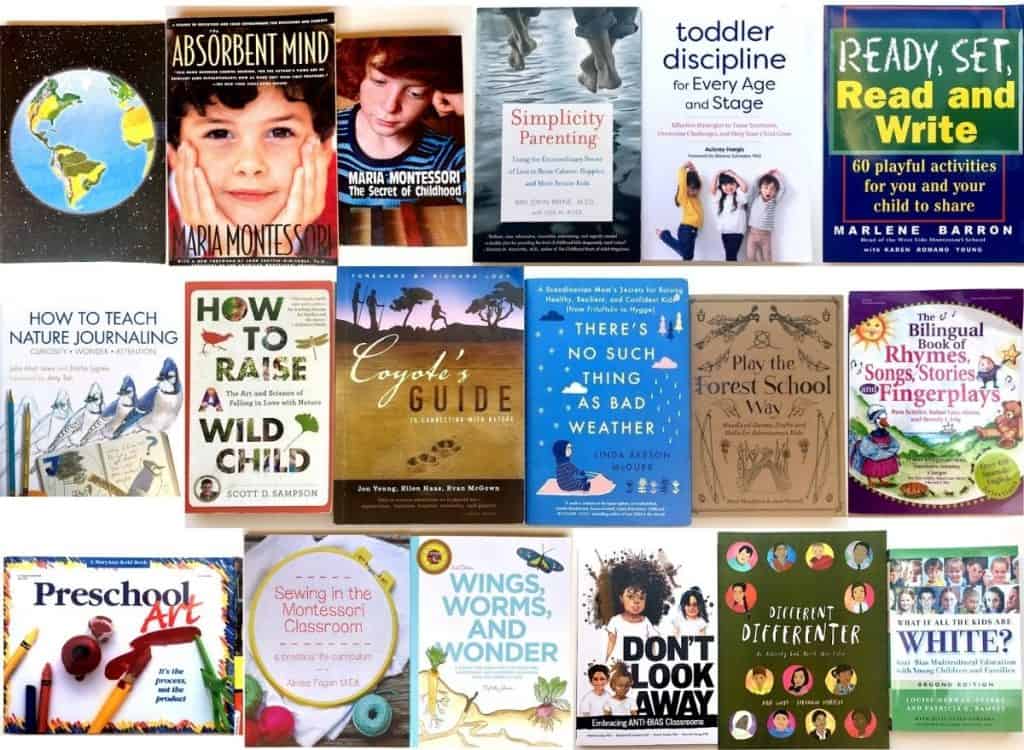
"Conventional schooling is forever in turmoil because of its poor ideological foundation. First, conventional schools are modeled on factories, because the birth of mass public schooling coincided with the age of efficiency...the factory model has a host of consequences that result in suboptimal learning conditions. The second poor model inherent in conventional schooling is an outmoded model of the child-learner inherited from behaviorism, in which the child is an empty vessel filled and shaped by deposited information, rewards, and punishments."
- Angeline Stoll Lillard
Today we're sharing our preschool and kindergarten homeschool curriculum. If you're planning to homeschool a child between the ages of 2.5-6, or even if you're just keeping your options open, this is the post for you.
Below, you will find the BEST preschool and kindergarten homeshool curriculum resources to guide you along your journey - all the way to the finish.
Disclosure of Material Connection: Some of the links in the post are “affiliate links.” This means if you click on the link and purchase the item, I will receive an affiliate commission. Amazon links are not affiliate links. You can read my full affiliate disclosure.
Every child is unique. All of these resources provide a great jumping off point for child-led exploration and joyful learning experiences. Also, they are robust enough to support you throughout these formative years. In fact, several of them were also featured in our elementary curriculum.
What is Montessori Education?
Montessori education is based on the educational philosophy of Dr. Maria Montessori. In stark contrast to the behaviorist view mentioned above, as a constructivist, Dr. Montessori believed that children learn by building their knowledge through their environment and the materials found within it. They are not empty vessels to be poured into.
Through scientific research, she found that a child-centered education consisting of a prepared environment and a prepared adult facilitates the healthy growth, development, and education of every unique child. It also fosters a relationship of mutual respect between the child and the adult.
Five Areas of Learning in Montessori Education
- Practical Life - Activities of daily life that focus on care of self, and care of one's environment.
- Sensorial - Materials and lessons that aid in the development of the senses.
- Language - Written and spoken language.
- Math - Path from concrete to abstraction beginning with concrete learning materials and number quantity, number recognition, the decimal system, etc., all the way to operations: +,x,-,/, and beyond.
- Culture - Umbrella subject area encompassing Geography, Science, History, Art, and Music.
Why Montessori Education?
There are a lot of reasons why parents and caregivers everyday are making the decision to incorporate Montessori philosophy and principles into their home life and their children's educations. Those reasons include fostering outcomes of independence, curiosity, creativity, empathy, respect, and joy in learning. There are nine insights or principles associated with Dr. Montessori's observation and work with children.
Nine Montessori Principles
- Movement and Cognition Relationship
- Freedom of Choice
- Executive Function Skills
- Interest in Subject Matter
- Absence of Extrinsic Rewards Associated With Activities or Skills
- Collaboration With Peers
- Contextual Learning
- Authoritative Style Teaching & Parenting - Freedom Within Limits
- Order
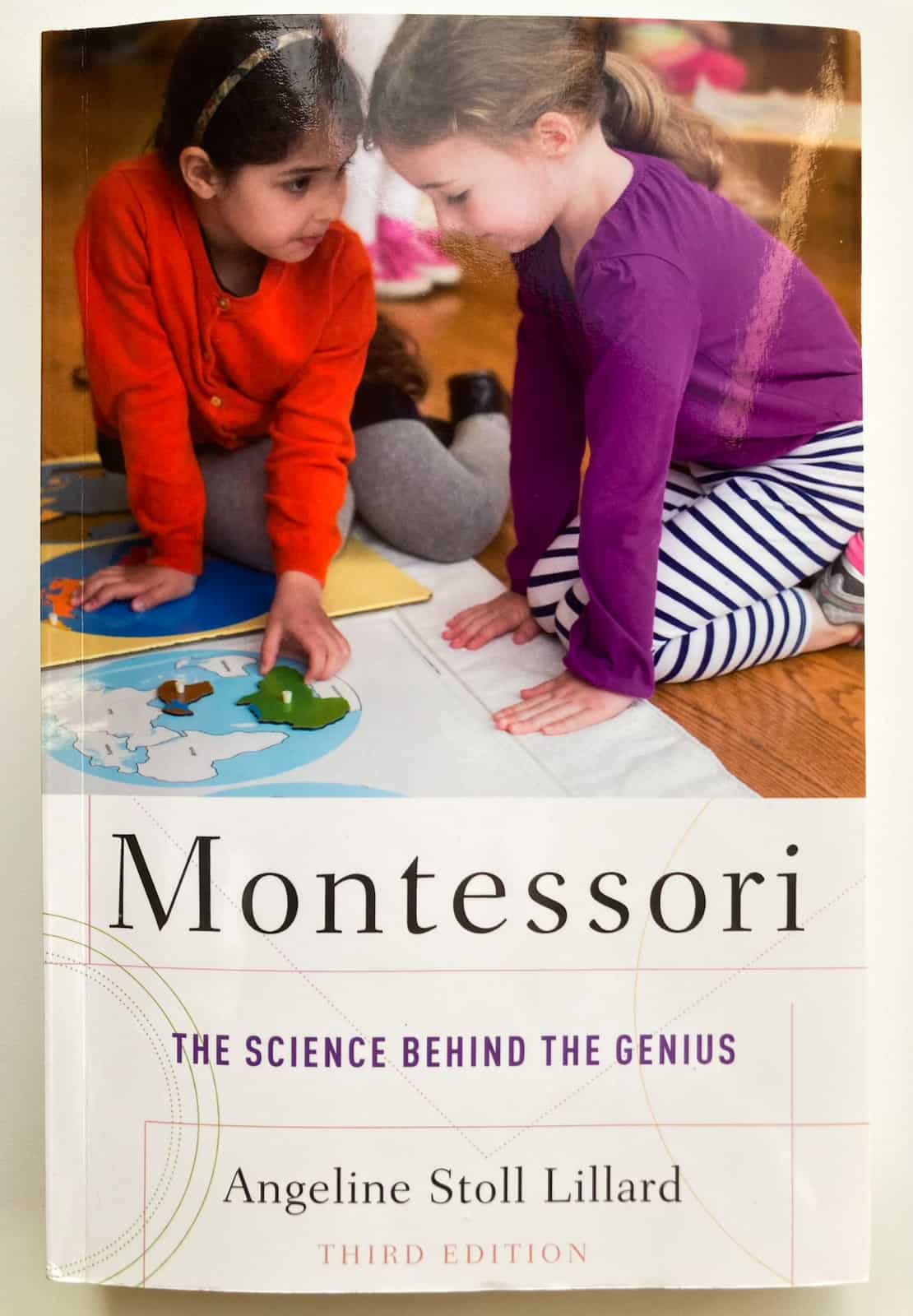
For the science behind the outcomes that inspire parents to transition to Montessori lifestyles for their family, along with an in-depth explanation of the nine Montessori principle topics, check out Montessori: The Science Behind the Genius.
This book is a very thorough and easy to understand explanation of the principles of Montessori education, and how they nurture healthy growth and development.
This brief TED talk by Katy Wright is another excellent resource for learning about what Montessori really is and why it's so important.
How to Know if a Child is Ready for Preschool
- Independence in Practical Life Activities - Dressing, Handwashing, Toilet Awareness, Grace & Courtesy
- Adjustment to Time Apart From Parent/Caregiver
- Sharpened Social Skills
Whether you are sending your child to a Montessori Primary classroom or implementing a program in your homeschool, there are several things you can observe to determine if your child is ready.

The Montessori Toddler by Simone Davies is my favorite book for the toddler years because it is a comprehensive resource. In fact, it even has a section specifically for families preparing for a Primary program.

How to Prepare for Homeschooling
- Educate yourself.
- Be flexible.
- Be mindful.
- Always follow the child.
Stick to those ideals and this is completely within your grasp. I often hear parents and caregivers sharing their beginning homeschooling experiences and it seems like folx mostly fall into two categories:
- They assume they'll be able to wing it (wishful thinking) and when issues crop up, they don't know how to respond. As a result, they get overwhelmed and want to give up, feeling like they just can't do it.
- They try to memorize and plan out every little detail, setting themselves up for frustration when their child is in a different rhythm or on an alternate path completely.
Don't fall into either of those traps. We've broken down our Montessori homeschooling resources into more specific categories than the five subject areas mentioned above.
Many of these preschool and kindergarten homeschool curriculum resources we found used. Starting simple and minimal supports growth through a child-centered approach.
Mastering practical life activities and the resulting development of executive function skills, such as concentration, are the foundation for other subject areas. As a result, practical life skills & gross-motor activities, along with time spent in nature and solid family reading habits, make for excellent homeschooling practices. The child will build from there. This supports and encourages a growth mindset in children.
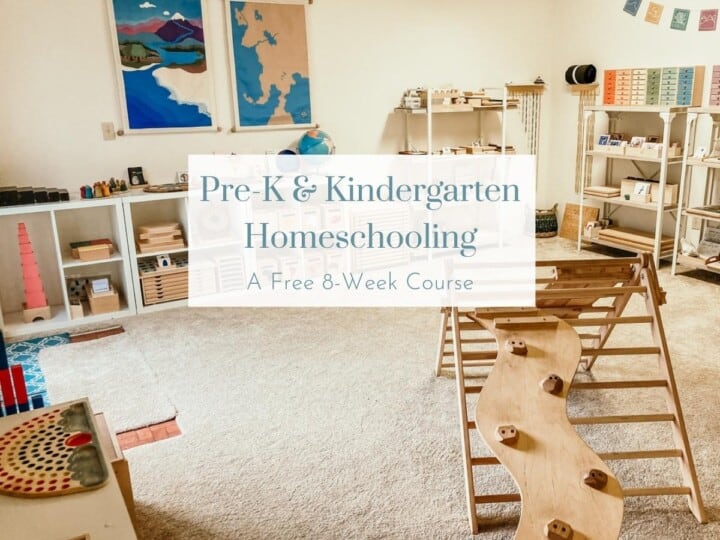
How to Homeschool
For teaching ages 2-6.
Free Pre-K & Kindergarten Homeschool Course
Would you like to learn more about how to homeschool your preschooler or kindergartener the Montessori way?
This 8-week course will provide parents and caregivers with a no-nonsense approach to homeschooling. You will learn how to homeschool using hands-on, child-centered, and diverse learning experiences.
This course covers ALL the relevant subjects. You'll receive information and insight that will help you identify what is best for your child. You'll also be introduced to plenty of free resources along the way.
Most importantly, you will walk away with the tools and resources you need to confidently begin your own homeschooling journey.
More on the primary homeschool course.
Montessori Primary Curriculum Resources
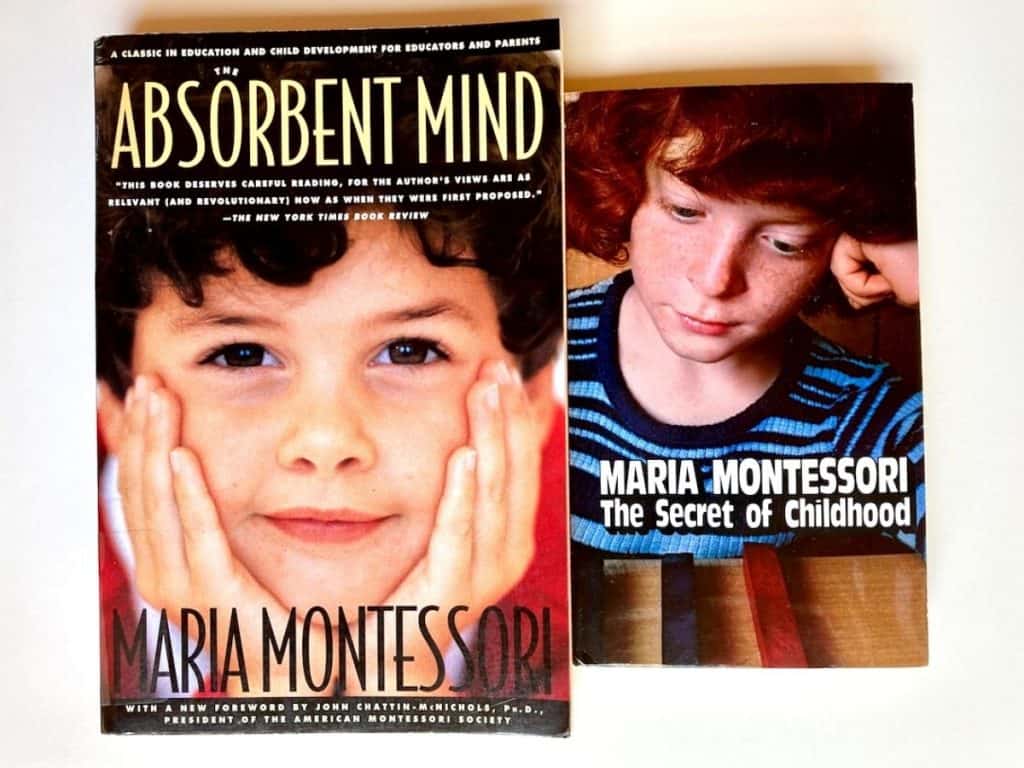
Dr. Montessori's Own Works
Maria Montessori's own works are a great choice when looking for Montessori primary curriculum. She was a pioneer in the field of education and these two books are some of her easier, more conversational reads. They are filled with insights about young children and will enhance any parent or caregiver's connection.
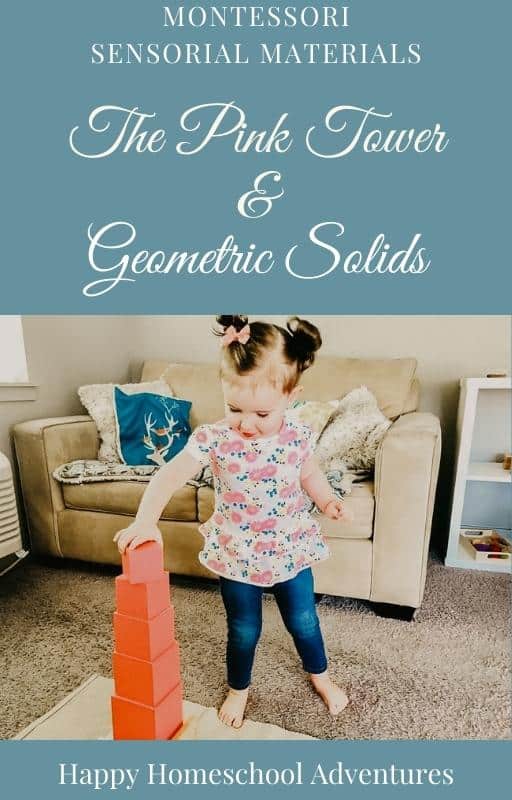
FREE Guide to Sensorial Materials
Learn how to use the iconic Pink Tower and Geometric Solids!
For more on authentic materials designed by Dr. Montessori, including how to use them in your homeschool, read about the pink tower and geometric solids.
Watch the video to see Noah demonstrate how to use the Montessori geometric solids sorting extension.

Parenting & Discipline
- Simplicity Parenting by Kim John Payne
- Toddler Discipline for Every Age and Stage by Aubrey Hargis
These two books are very helpful when getting started with a preschool and kindergarten homeschool curriculum. It would be prudent to check them out before purchasing a lot of materials, making changes to your home environment, or developing a daily rhythm.
These books will help you set goals and realistic expectations. Toddler Discipline is clear and concise, making it the perfect choice for a quick shelf reference.
You'll find that the strategies and practical tips inside these resources nurture calm and connection among family members. You can find more on our Self-Reflection, Mindfulness, Parents & Educators book list.
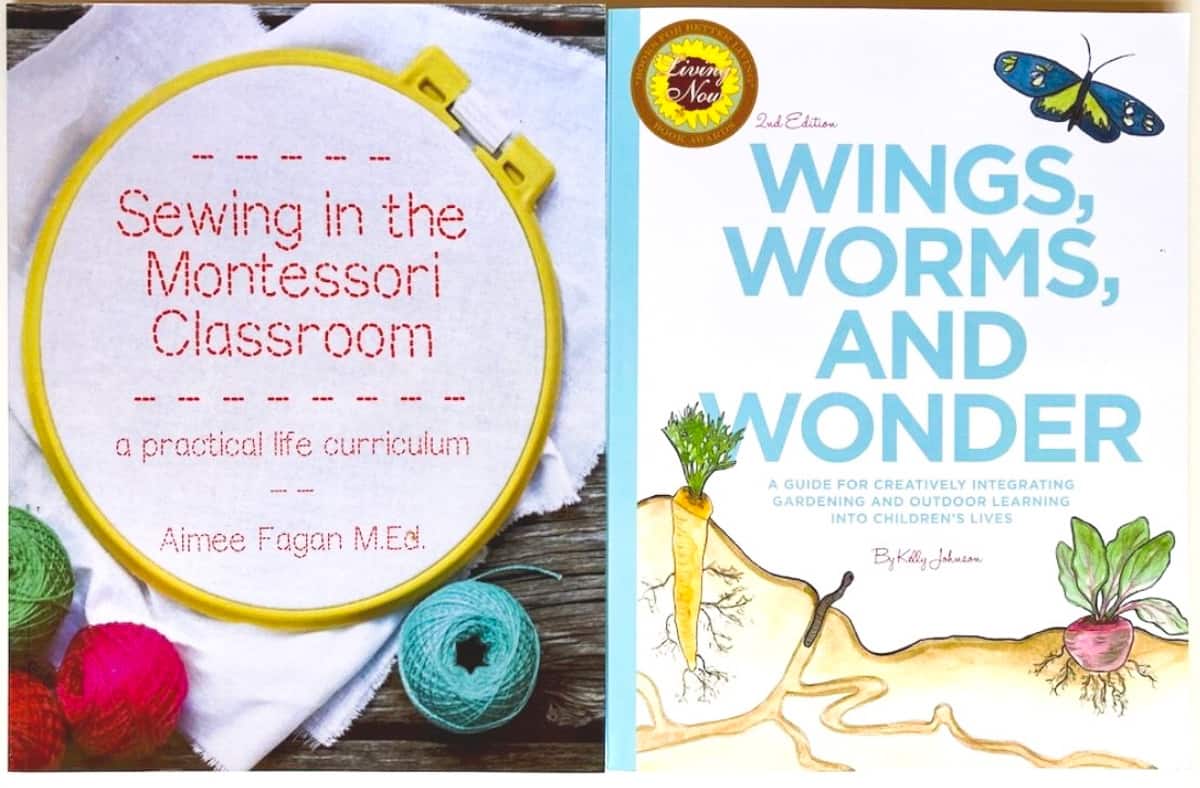
Practical Life
- Practical Life in the Kitchen
- Sewing in the Montessori Classroom by Aimee Fagan
- Wings, Worms, and Wonder by Kelly Johnson
- Montessori Pets and Caring for Animals as Practical Life
We have several free resources for cooking and baking with preschoolers and up. These recipes are perfect for pre-readers as well as those practicing their reading skills.
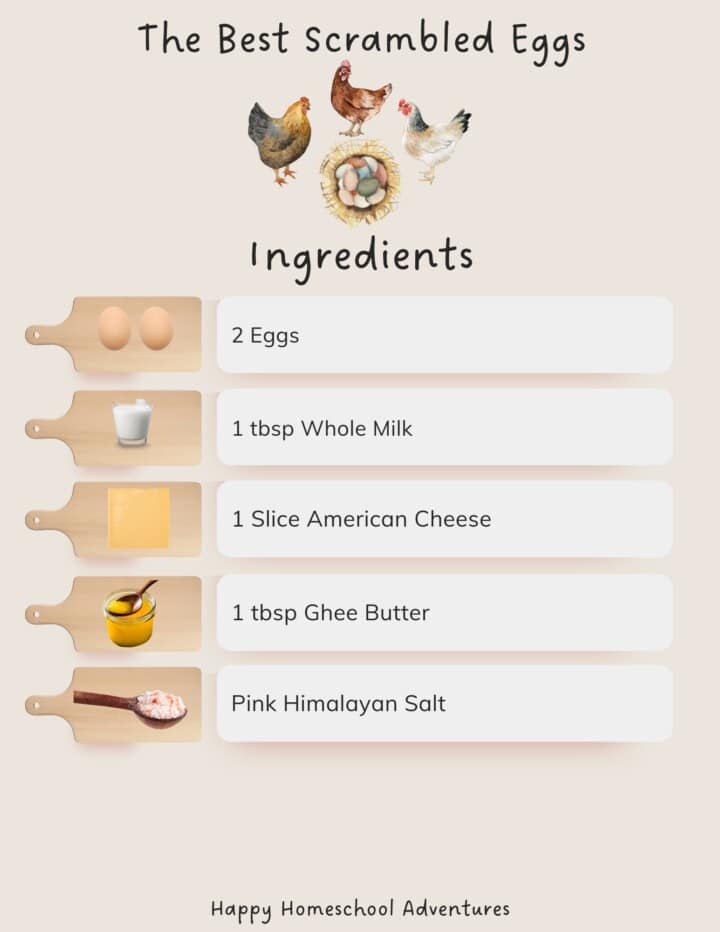
FREE Scrambled Eggs Recipe
For you to try at home!
Our favorite beginner recipe is Scrambled Eggs. Kids can gather the ingredients using the ingredient list, gather equipment using the equipment list, and work towards confidence and independence in the kitchen with each recipe.
The sewing curriculum really helps with the development of fine-motor skills and concentration while nurturing an essential skill set.
Wings, Worms, and Wonder is also part of our elementary curriculum resources. We've found that it also contains some creative learning experiences for the 3-6 age range.
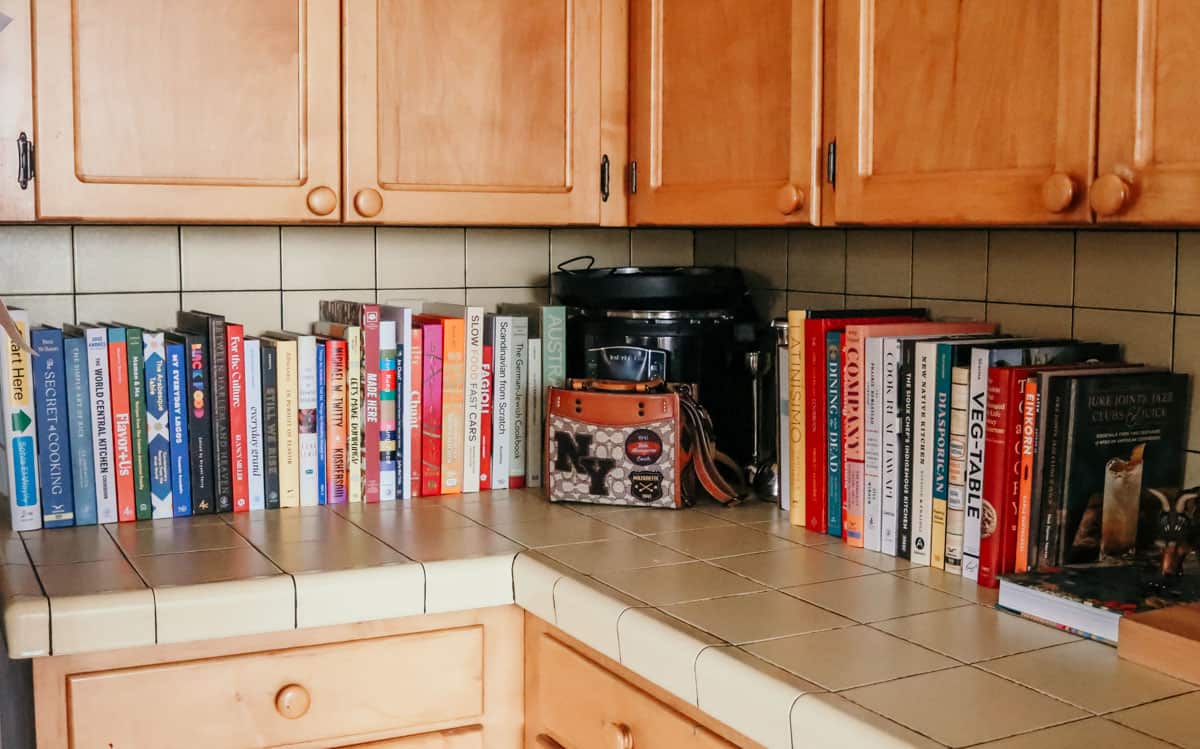
We have lots more inspiration for Practical Life in the kitchen and food for every continent. Many of these experiences are from our collection of beautiful and diverse cookbooks.
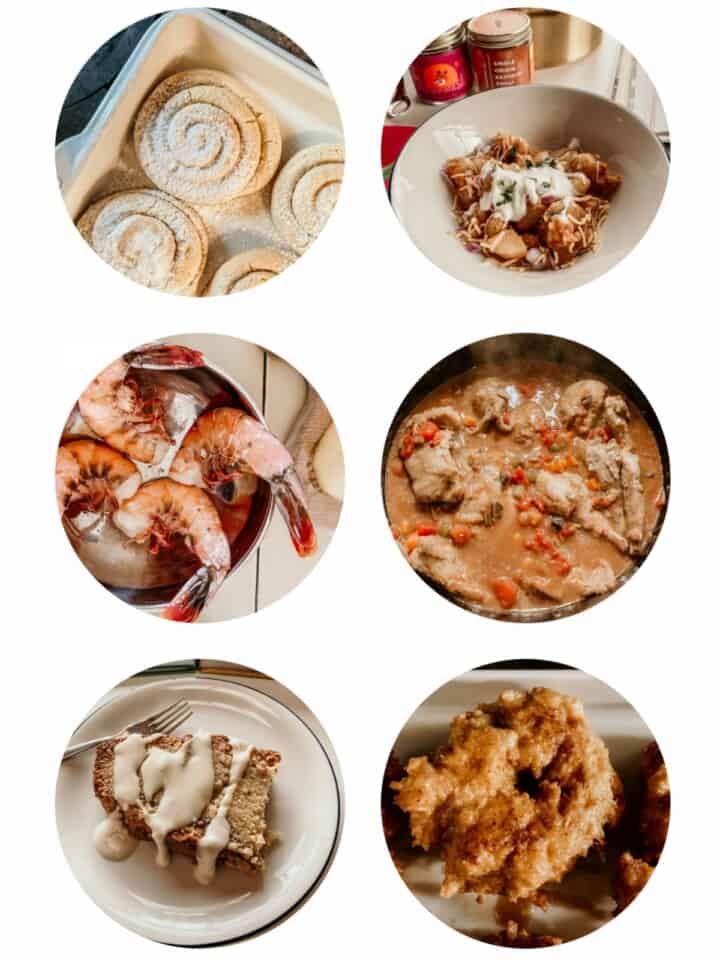
Food from Around the World: Free Cooking Lessons
Learn from some of the most talented chefs around the world!
Free Cooking Course for Families
Discover recipes for every continent! Sign up to receive free cooking lessons for the whole family. Learn from some of the most talented chefs around the world and participate in the quality practical life experiences Montessori education is known for.
Find out more about the cooking course.
Family & Kids' Cooking Resources
Beautiful and diverse cooking resources for you!

You can also stop by our shop to see more Family & Kids' Cooking Resources, including Flavor+Us: Cooking for Everyone by Rahanna Bisseret Martinez, Top Chef Junior finalist. In this cookbook, Rahanna shares recipes from around the world that respect Mother Earth, workers, & consumers.
Free Cooking Course for Families
Sign up to receive free cooking lessons for the whole family. Learn from some of the most talented chefs around the world and participate in the quality practical life experiences Montessori education is known for.
There are recipes for every continent and they're excellent resources for kids to keep in their continent boxes along with other geography and culture materials.
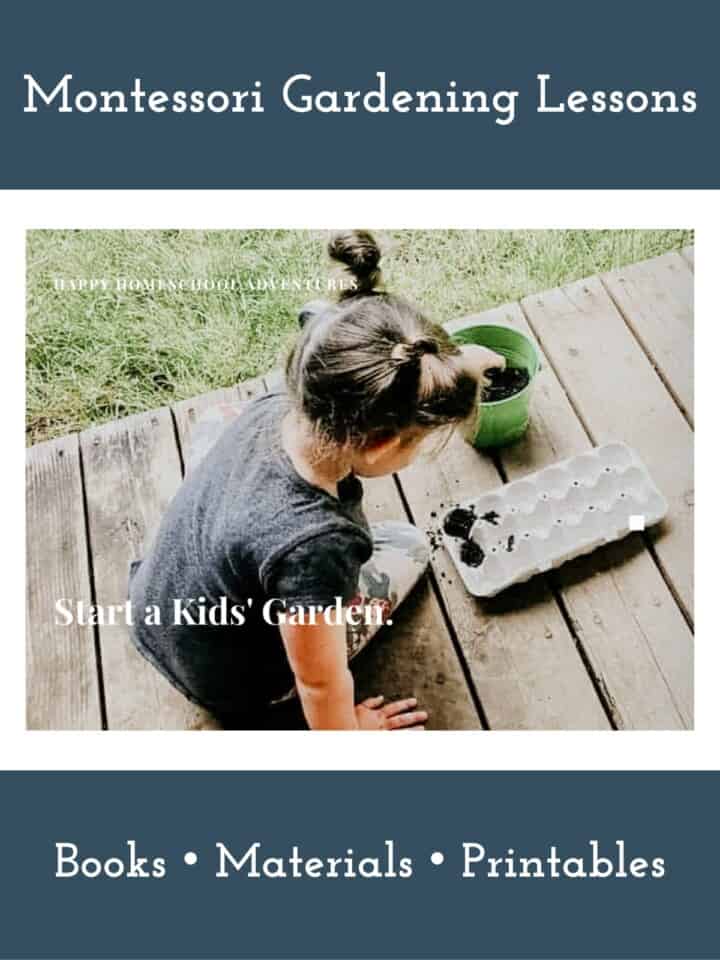
Start a Gardening Program
Free Gardening Lessons for Kids & Adults.
Start a Garden with Kids
Keep it Simple. Using household materials and simple tools, empower kids to grow food and eat healthy with this easy series of lessons that will help you start a garden with your learners.
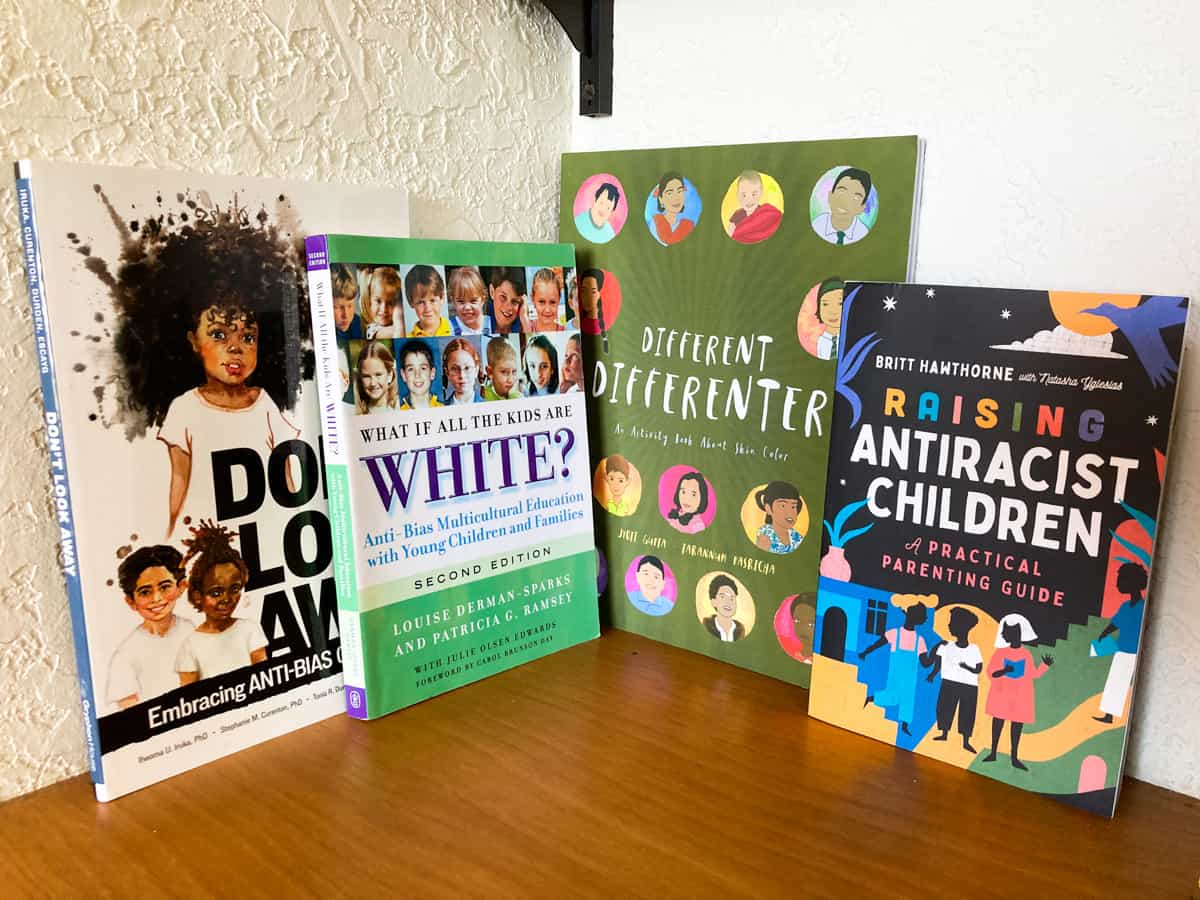
Anti-Bias Education Resources, Peace Curriculum
- Don't Look Away by Iheoma Iruka, Stephanie Curenton, & Tonia Durden
- What If All the Kids Are White? by Louise Derman-Sparks and Patricia G. Ramsey
- Different Differenter by Jyoti Gupta
- Raising Antiracist Children: A Practical Parenting Guide by Britt Hawthorne with Natasha Yglesias
- Native-Land.ca
- The Indigenous Digital Archive Treaties Explorer
Raising Antiracist Children is a must-have parenting guide for change. Even if you don't homeschool, I highly recommend you pick up this book.
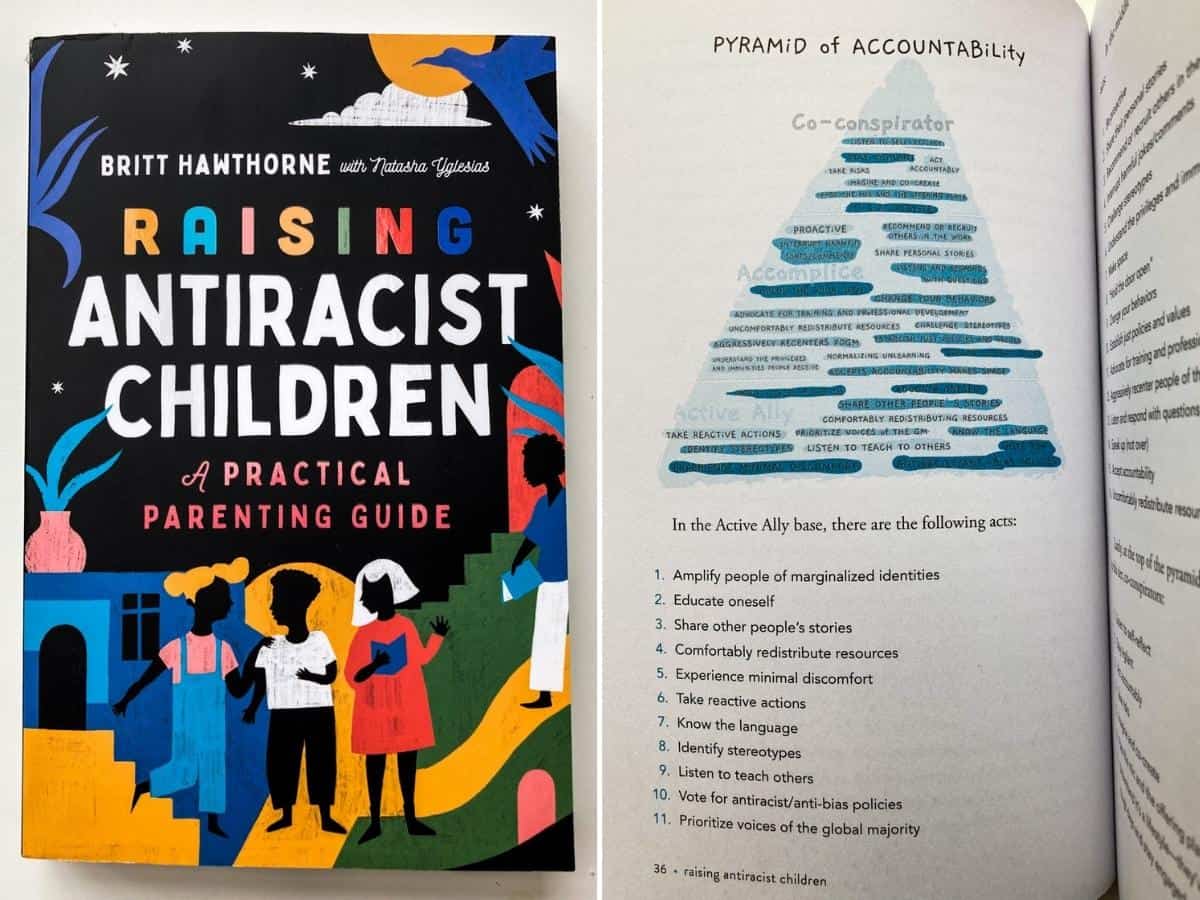
If you’re not familiar with Anti-Bias Education and would like to learn more about it, Introduction to Anti-Bias Education by ABAR teacher-educator Britt Hawthorne is another great place to start.
Our little ones have been enjoying activities from Different Differenter since adding it to our Art and Handwriting Space.
Native Land and the IDA Treaties Explorer were very helpful for researching the land where you live and for creating a meaningful Land Acknowledgment.
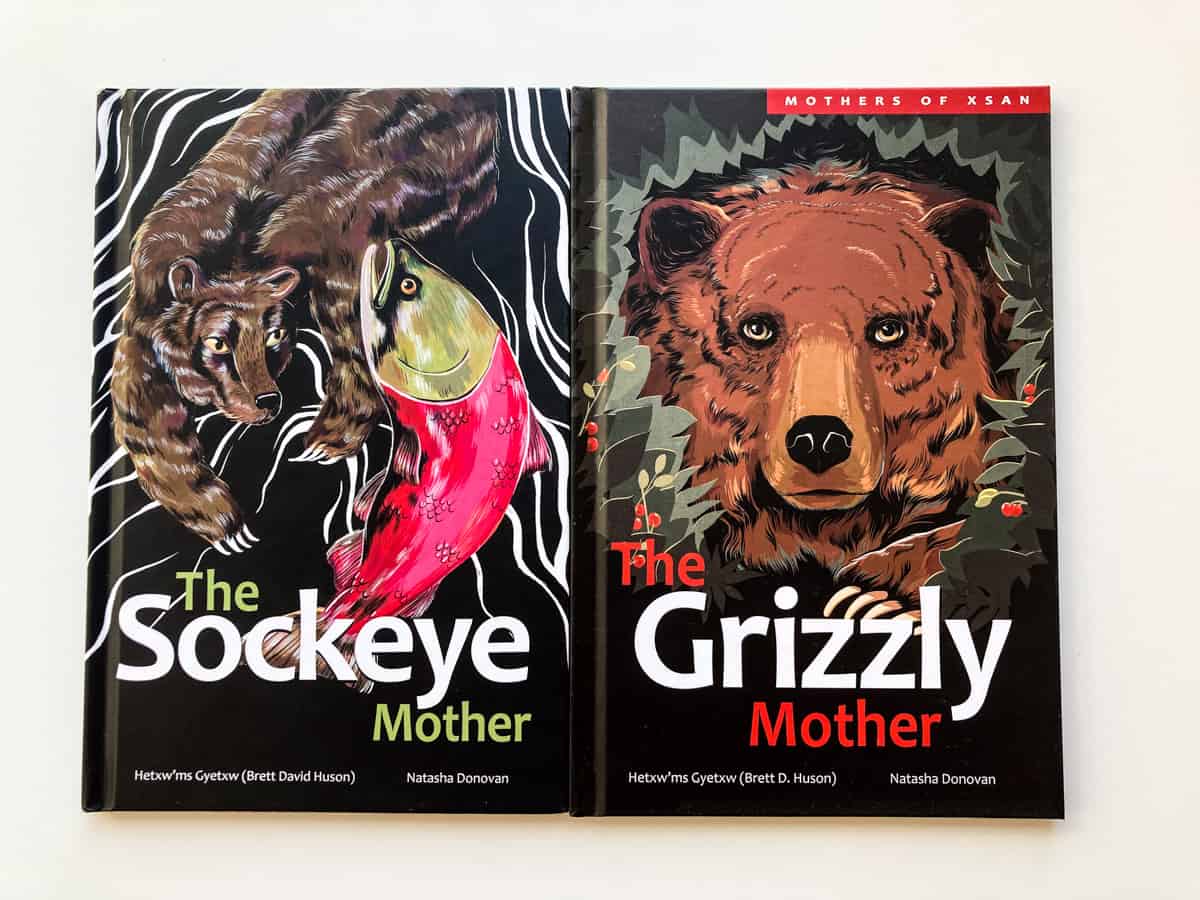
We continue the learning in our homeschool as well as through this collection of Indigenous Education Books. These books can be seen throughout our site. An example is this Mothers of Xsan series by Hetxw'ms Gyetxw (Brett D. Huson) and illustrated by Natasha Donovan.
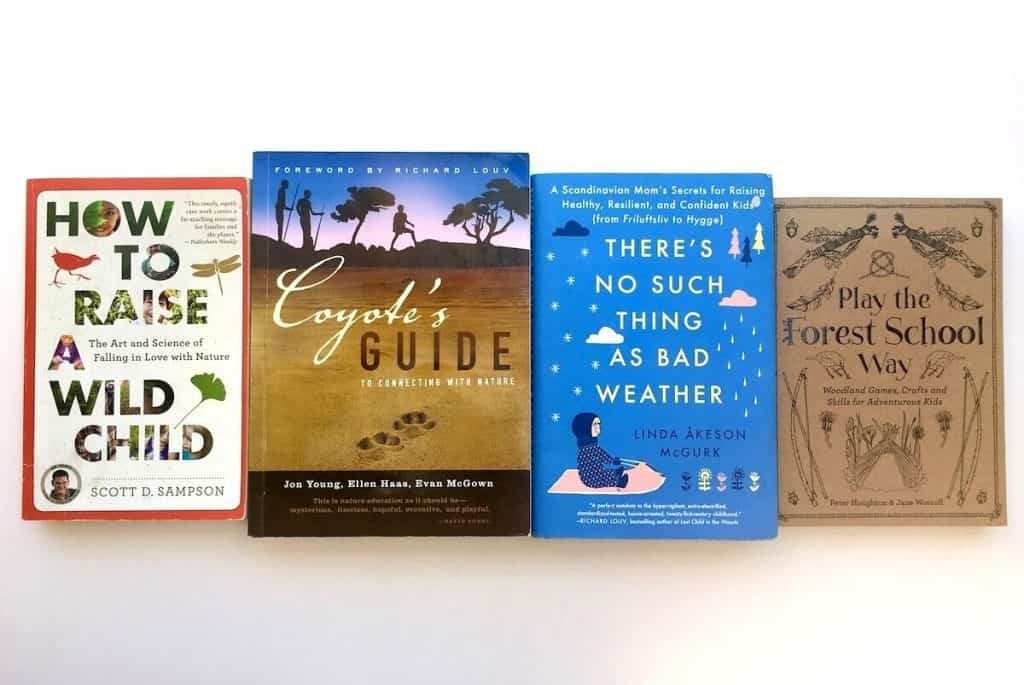
Preschool and Kindergarten Science & Nature
- How to Raise a Wild Child by Scott D. Sampson
- Coyote's Guide to Connecting With Nature by Jon Young, Ellen Haas, and Evan McGown
- There's No Such Thing as Bad Weather by Linda Akeson McGurk
- Play the Forest School Way by Peter Houghton and Jane Worroll
- Waseca Biomes Curriculum
- Natural Curiosity 2nd Edition
- Building a Native Forest Garden with The Earth Project (FREE)
- Seasonal Activities
These are all excellent nature education resources for a preschool and kindergarten homeschool curriculum and they each come from a different perspective. The first three books include a lot of background information, fundamentals, and practical tips for parents and educators. I would recommend starting with How to Raise a Wild Child and There's No Such Thing as Bad Weather.
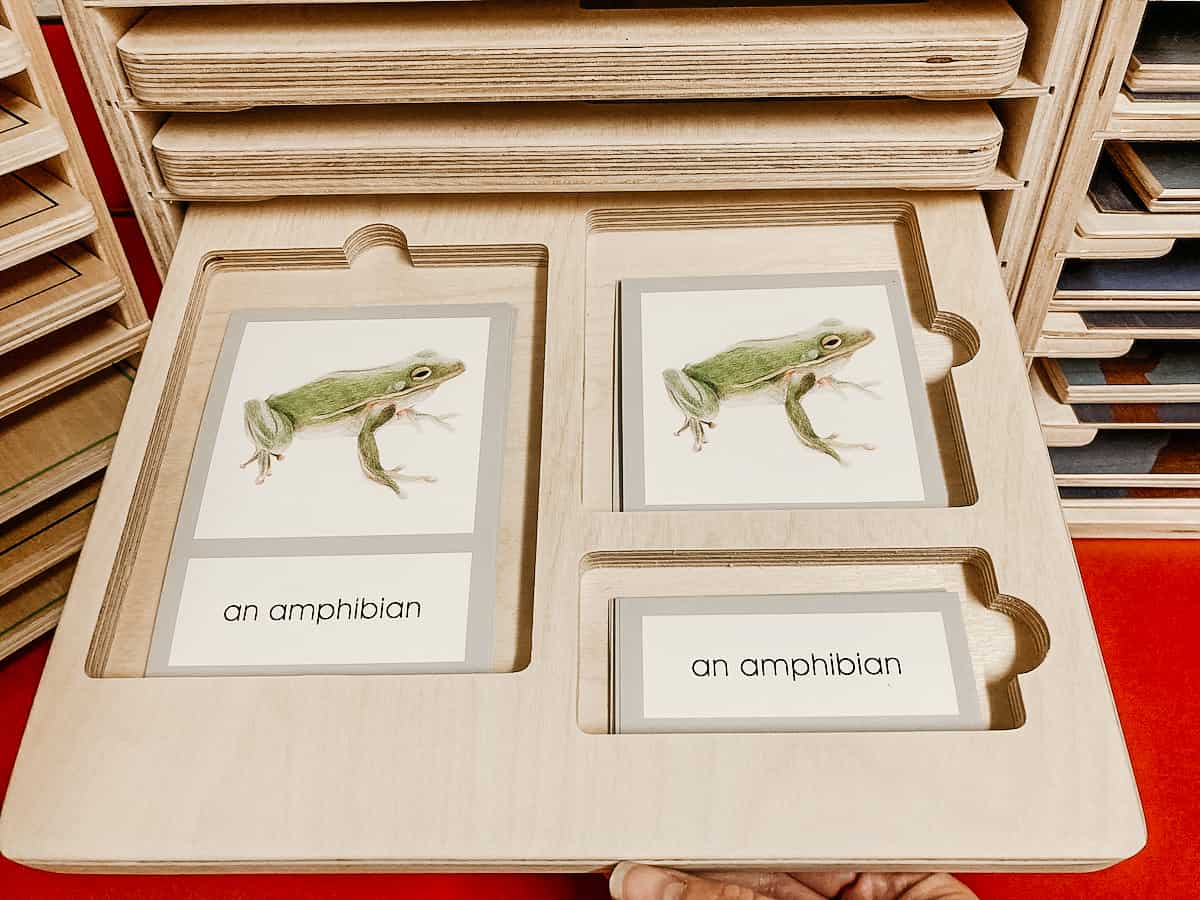
Waseca Biomes integrates several subject areas into their materials so kids are getting the most out of their learning opportunities. The materials come with a guide that includes the presentations and the curriculum book (listed above) gives guidance about when to consider introducing these materials.
Save $15 on your first Waseca Biomes purchase here.
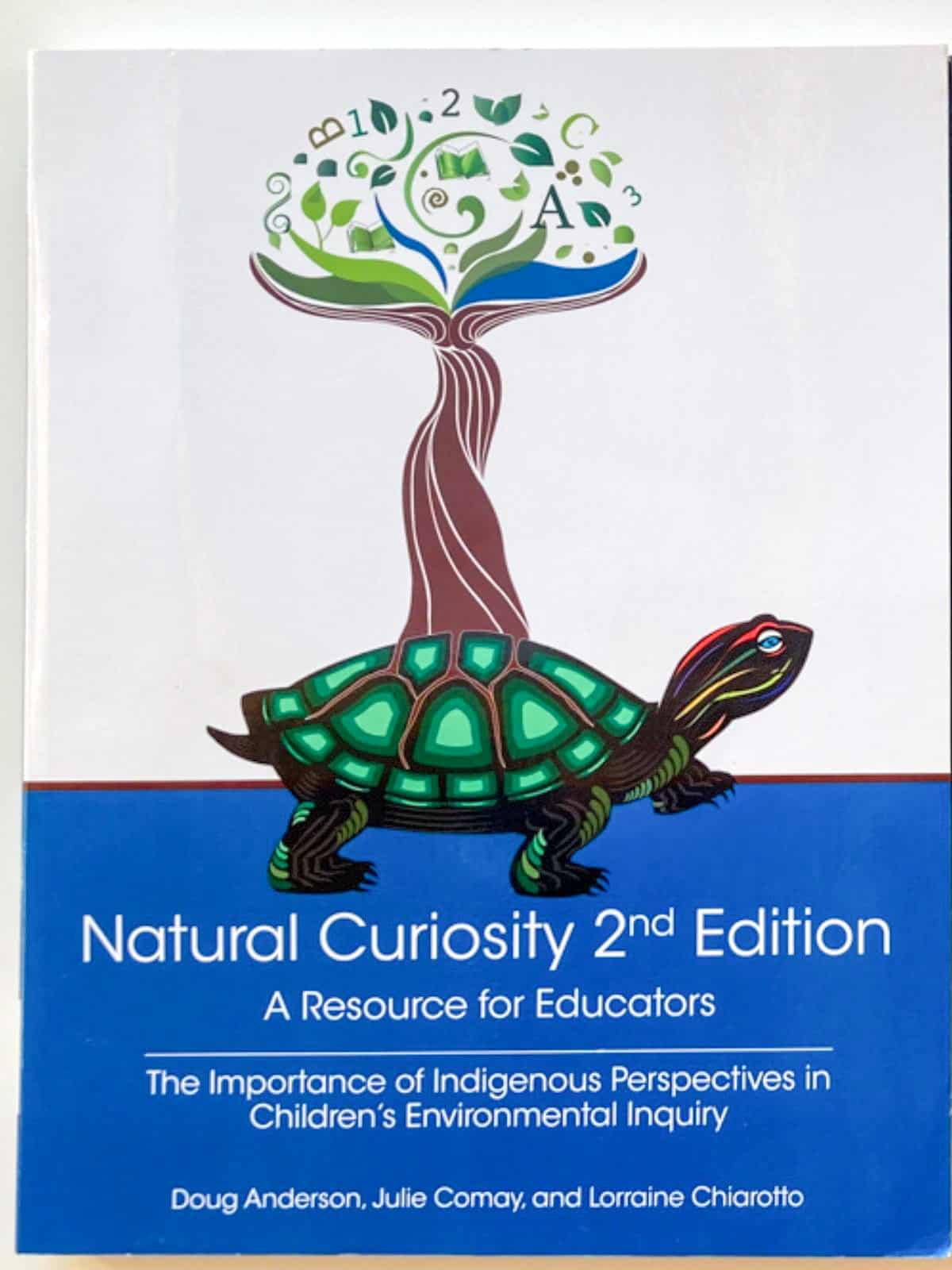
Natural Curiosity 2nd Edition was added this past winter and we're excited to begin using it more. You'll find Indigenous wisdom and opportunities for experiential learning in this resource.
The Earth Project is a global project that aims to connect Montessori schools and families together in a collaborative effort to save the planet.

Art for Preschool and Kindergarten Homeschool Curriculum
- Preschool Art: It's the Process, Not the Product by Maryann Kohl
- Mommy, It's a Renoir! by Aline D. Wolf
- Draw.Write.Now. by Kim Stitzer and Marie Hablitzel
These are great resources for process Art and Art appreciation. Our Fall Leaf Painting is a great example of our fun with Process Art experiences.
We didn't even need to purchase the postcards that are sold separately from Mommy, It's a Renoir! We applied the methods described in the book to postcards our daughter picked out. It worked out really well.
I discussed the Draw.Write.Now. series in our Art and Handwriting Space post. Our kids prefer them over any other art and handwriting curriculum we've tried and they tie in well with our Geography studies.
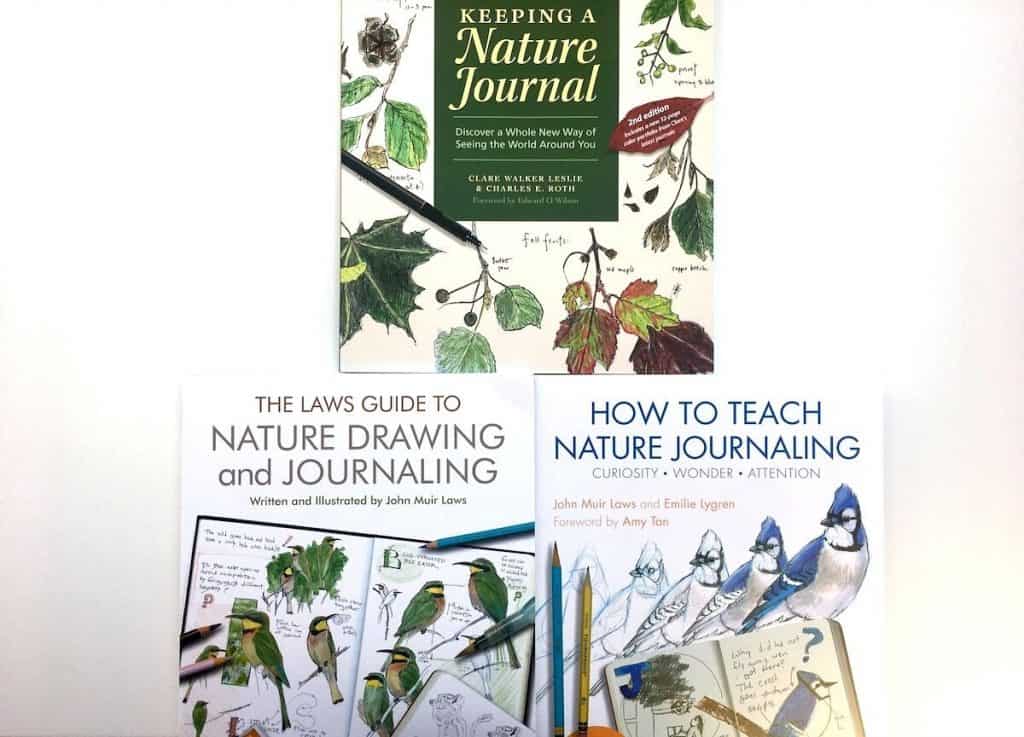
Nature Journaling Resources for Preschool & Kindergarten Homeschool Curriculum
- Keeping a Nature Journal by Clare Walker Leslie
- The Laws Guide to Nature Drawing and Journaling by John Muir Laws
- How to Teach Nature Journaling by John Muir Laws
All three of these nature journaling books are wonderful. They assume no prior level of mastery and they're just plain fun.
However, if you were to pick one to start out with this upcoming school year, I would recommend choosing How to Teach Nature Journaling. It's geared towards educators looking to encourage a nature connection in children, includes field activities, and is a great interdisciplinary tool.

Preschool and Kindergarten Homeschool Curriculum for Music
- First Steps in Music by John M. Feierabend
- The Bilingual Book of Rhymes, Songs, Stories, and Fingerplays
- Song School Spanish - Music CD Only
- Suzuki Recorder: Soprano Volume 1 by Alfred Music
- Montessori-Inspired Music History Bundle - printable
- Montessori-Inspired Music Theory Bundle - printable
- Faber's My First Piano Adventure - Writing Book A & Lesson Book A
The books above are great additions to any preschool and kindergarten homeschool curriculum. The Bilingual Book is very thick and our kids really enjoy it. We have been using it and the Song School Spanish (CD only) for Spanish language exposure also.
The piano and recorder resources include methods that support children playing music before actually learning how to read it. We prefer this approach as we feel it enhances their enjoyment.

Preschool and Kindergarten Reading
- Powerful Literacy in the Montessori Classroom: Aligning Reading Research and Practice
- Uncovering the Logic of English: A Common-Sense Approach to Reading, Spelling, and Literacy
- Ready, Set, Read and Write by Marlene Barron
- Waseca Reading Program by Waseca Biomes
- Draw.Write.Now. Art and Handwriting
- Bilingual Spanish-English Books
Powerful Literacy in the Montessori Classroom provides up-to-date analysis and implementation of the best practices related to teaching reading. It aligns with Montessori pedagogy as well as The Science of Reading. It's a must-have resource for preschool through lower elementary educators.
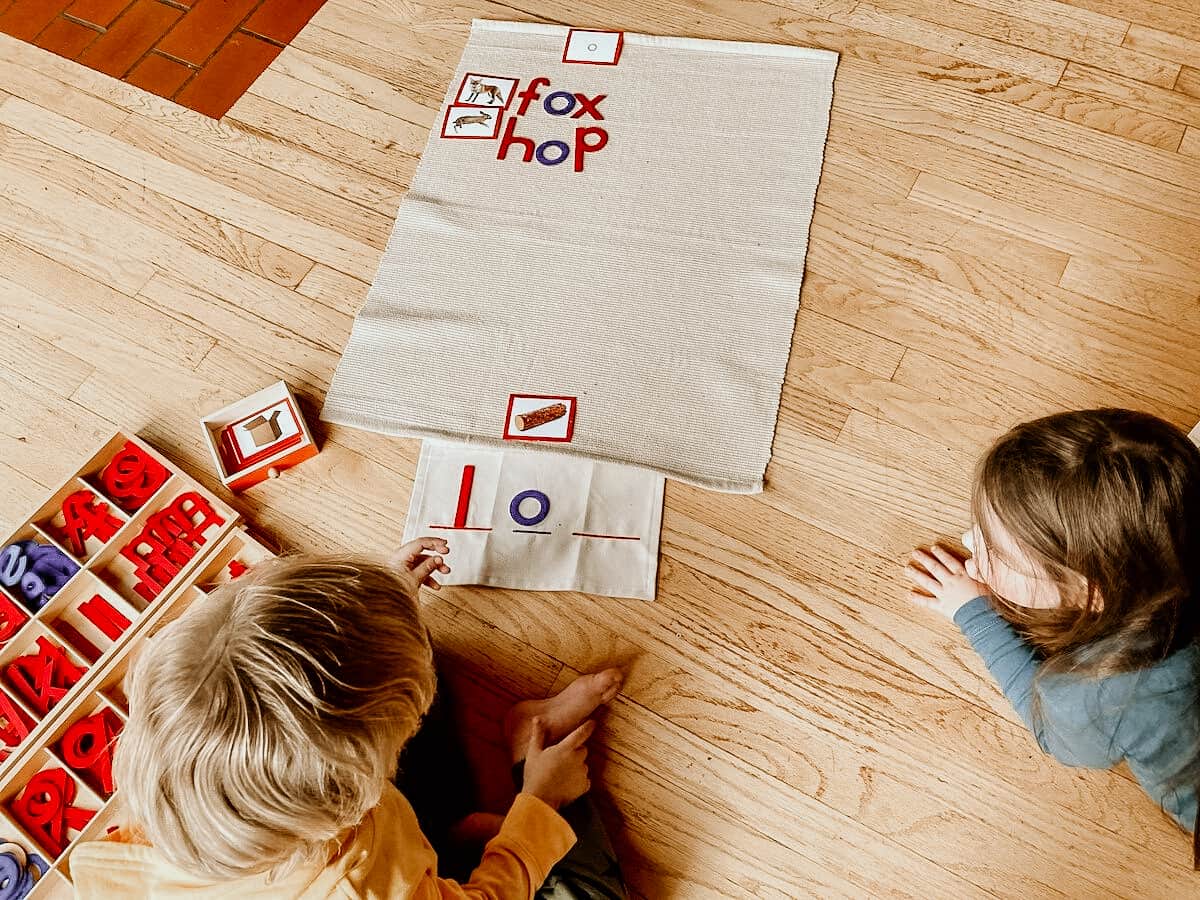
Waseca Biomes Reading Program, Sentence Building, and Readers
We also use Waseca's Reading Program. It's easy for our children to track their own progress, they love opening up the drawers with beautiful images. Most importantly, it supports the concept of writing before reading by building words using the Montessori movable alphabet.
In the image above, our son builds the word on the card using the CVC (consonant-vowel-consonant) mat with the movable alphabet. He then transfers the card and the letters to the larger work mat. Next, he matches the labels to the cards and reads the booklet in the drawer. As kids progress through the program, they no longer use the CVC mat.
The final step for each drawer is handwriting practice in print or cursive. This is a FREE downloadable resource found on their website in the pdf library. Also included is the progress chart for our little ones to mark off as they go.
This Reading Program is also a downloadable resource now, which makes it very affordable.
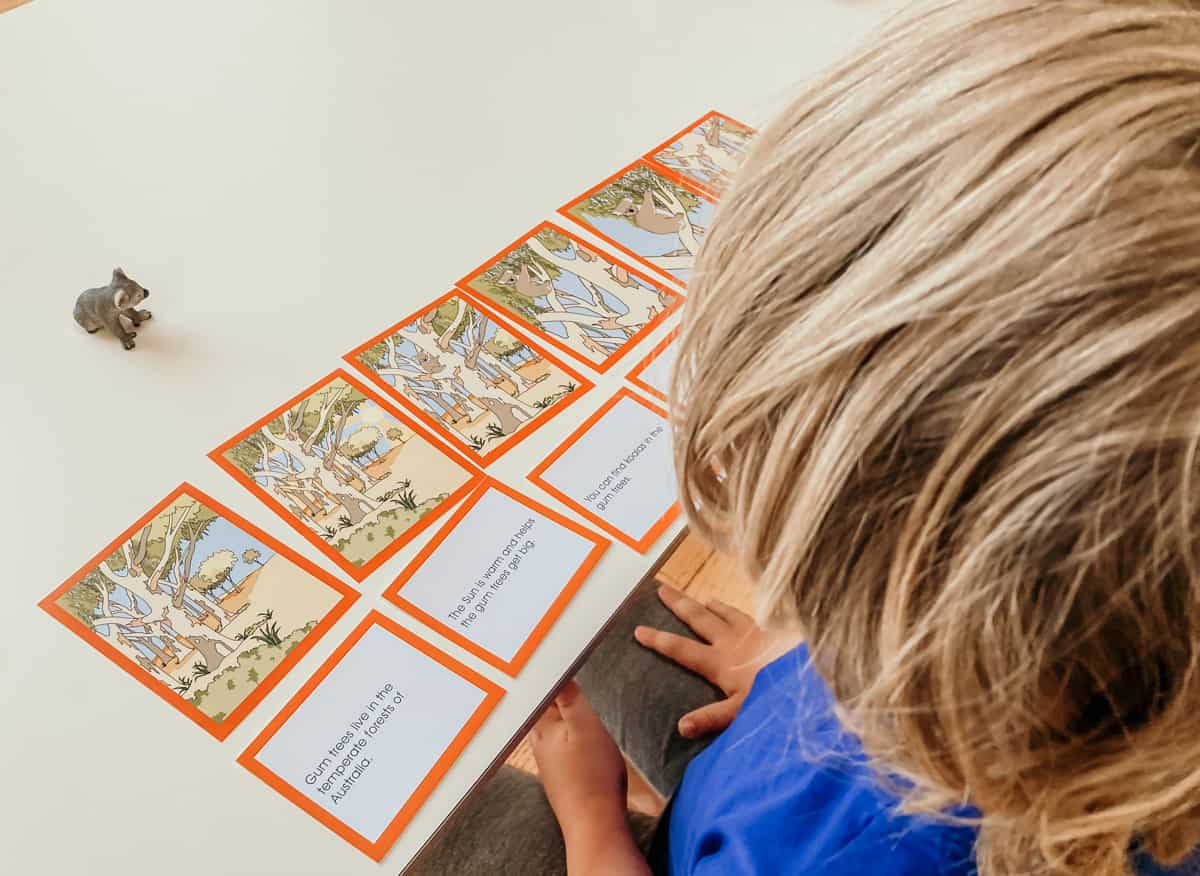
The Waseca Biomes Readers, and Sentence Building are color-coded to correspond to the reading program.
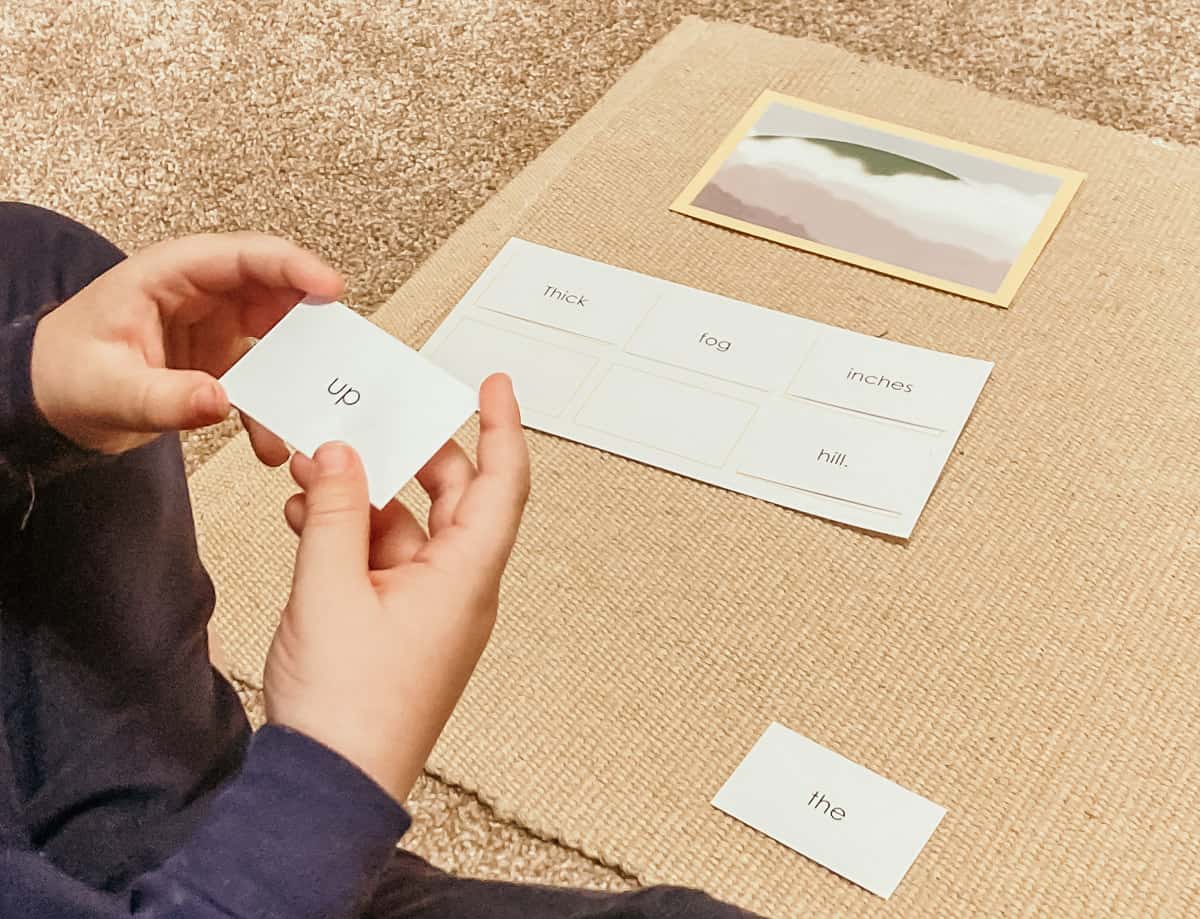
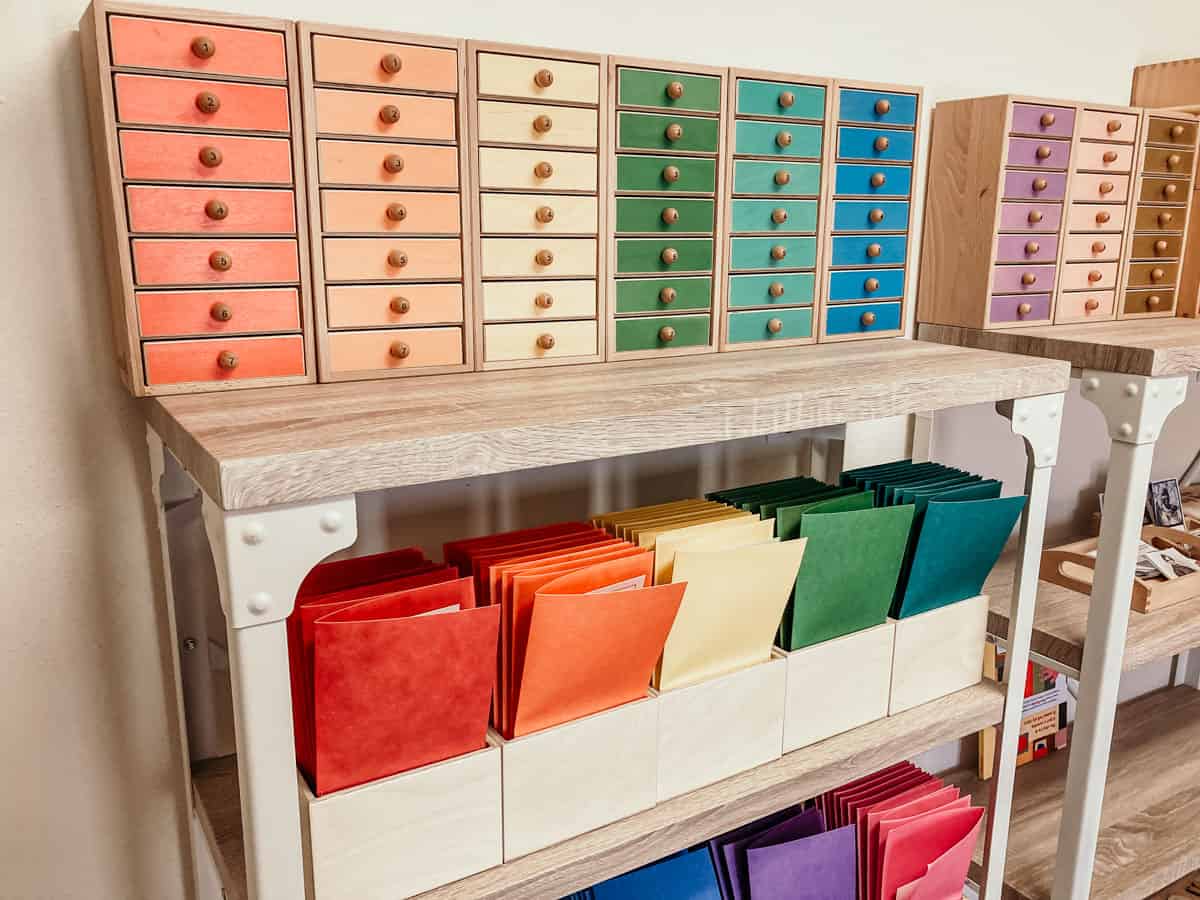
Additional Reading Assistance
You can save $15 on your first Waseca Biomes purchase here.

Monarch Readers are decodable phonics readers aligned with The Science of Reading and Montessori pedagogy.
If you're looking for courses specific to teaching a child to read, Seemi from Trillium Montessori has several affordable ones that can help: Learning Letters, Making the Most of the Movable Alphabet, and Phonetic Reading. They are also occasionally discounted.

Preschool Math
- Math Works: Montessori Math and the Developing Brain by Michael Duffy
- Teach Your 3-7 Year Old Math by John Bowman
- Montessori-aligned Materials by Mirus Toys
- Printables (Get 16% Off your first purchase)
Both of the books pictured above are excellent resources for preschool and kindergarten homeschool curriculum. If you're looking for specific guidance in Math and the use of traditional Montessori, Montessori-aligned, or DIY materials, I would recommend Teach Your 3-7 Year Old Math.

In the above picture, our son is working with the popular Addition Snake Game as a hands-on approach to practicing addition. You can find more on our Math journey for the Primary years in our Montessori Math at Home and Math: Concrete to Abstraction.
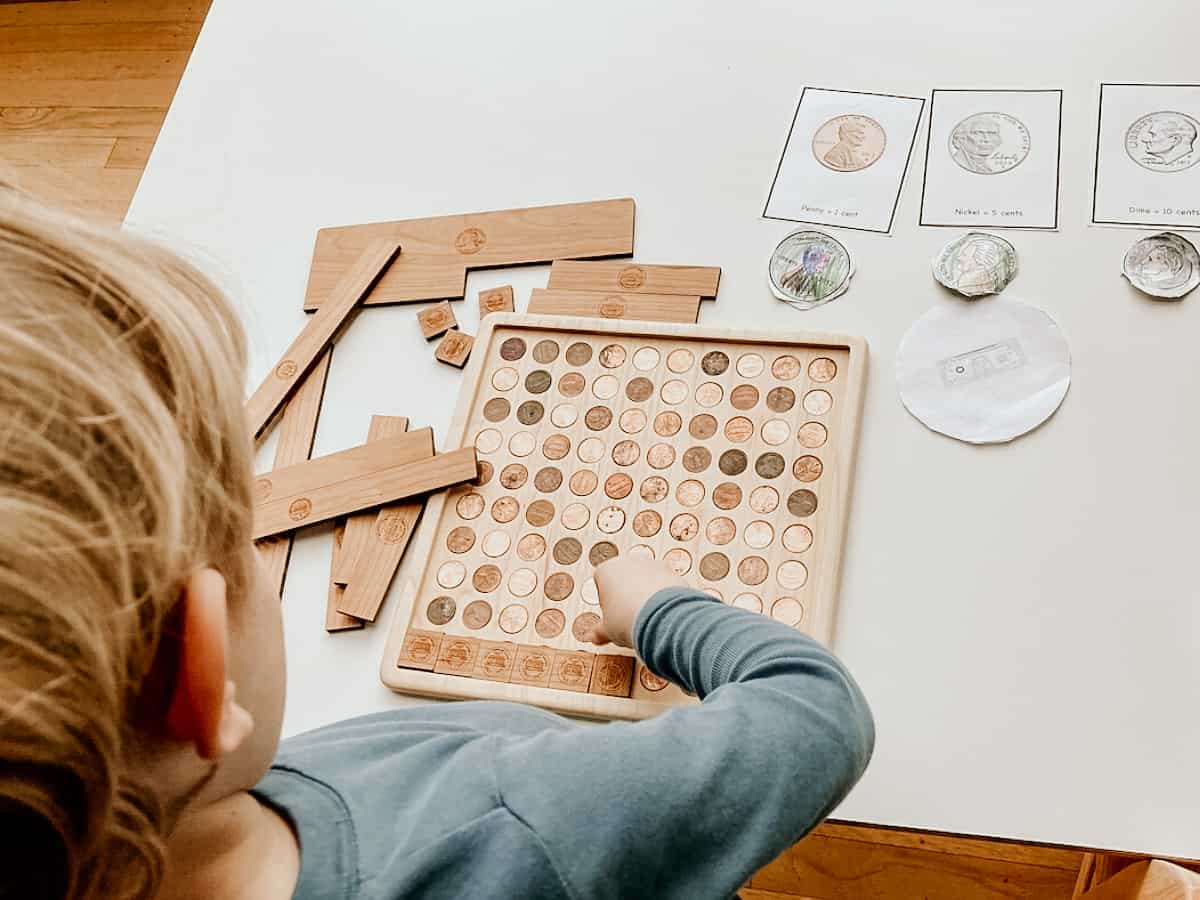
This Mirus Toys dollar counting board is great for learning about coin denominations as well as their relationships to each other, including how to exchange and various combinations for creating the value of a dollar.
Need some help with understanding the progression of Math activities in your homeschool? Montessorikiwi has a really helpful Math Scope and Sequence for ages 3-12. If you follow us on Pinterest, you will find it pinned under Montessori Math.
If you're looking for a course specific to Math in the early years, Trillium Montessori offers Building Number Sense for teaching ages 2-4.

Science & Geography for Preschool and Kindergarten Homeschool Curriculum
- Waseca Biomes Curriculum
- Montessori-aligned Materials and Guides by Mirus Toys
- I Wonder What's Out There by Joanne DeFilipp Alex
You may notice that Science is listed twice in our preschool and kindergarten homeschool curriculum resources. There's so much overlap between science and these other subjects that it important to point out.
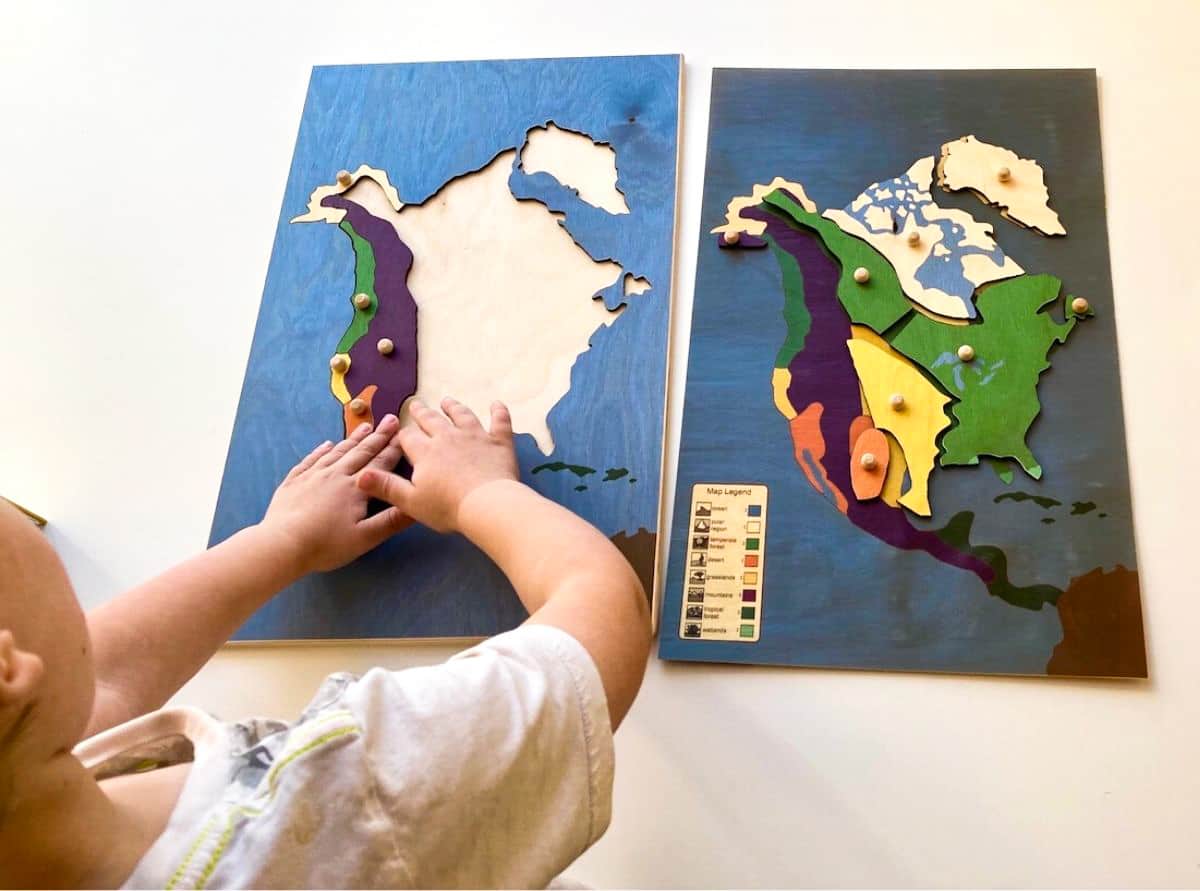
A lot of our preschool and kindergarten science and geography curriculum comes from Waseca Biomes and we are very happy with it. The materials are durable, eco-friendly, and beautiful. You can find more examples of how we use them in this Antarctica Continent Study for Preschool.
Save $15 on your first Waseca Biomes purchase here.
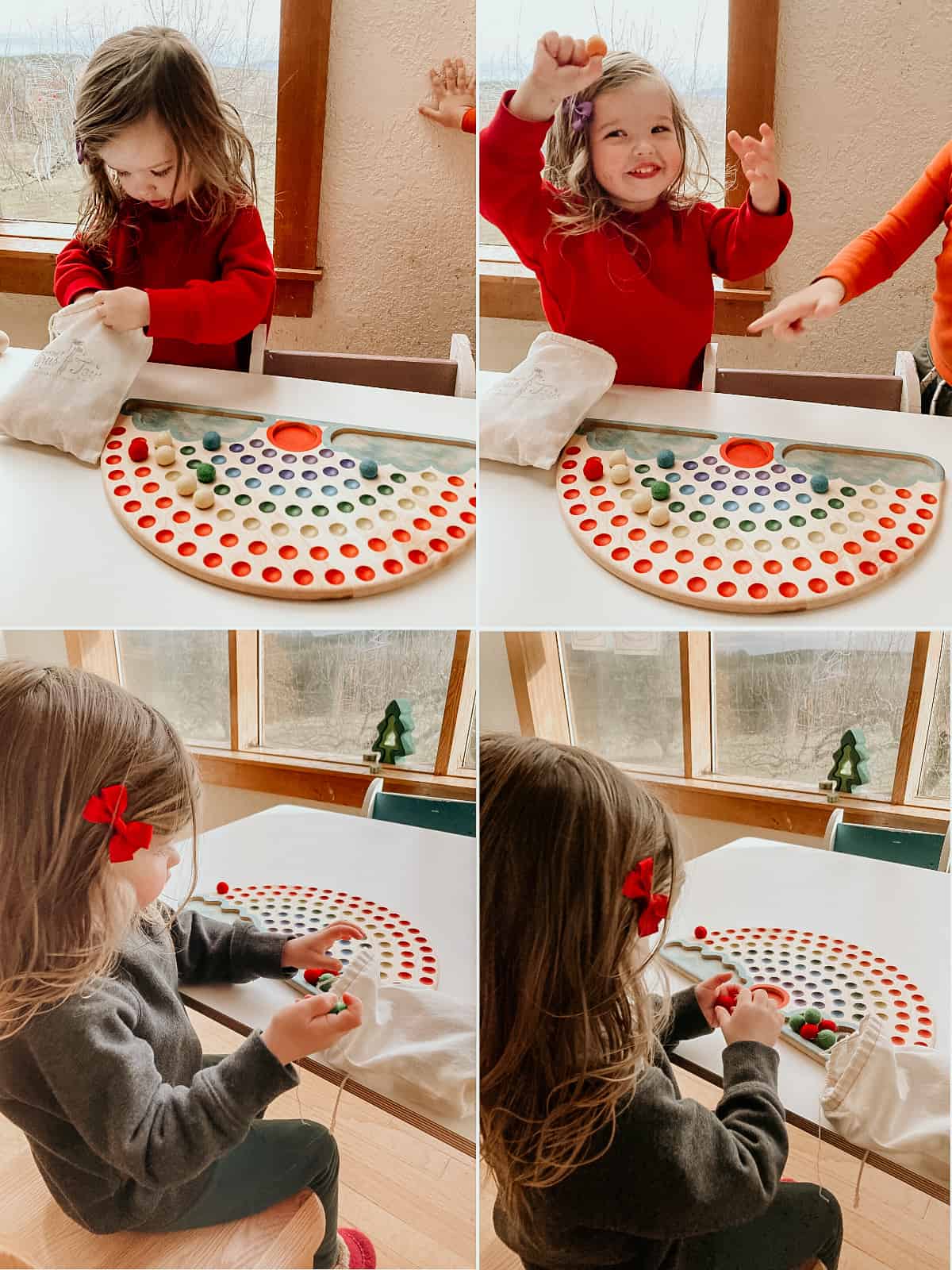
Mirus Toys
Our preschool and kindergarten curriculum resources contain a nice collection of materials from Mirus Toys. We're very happy with the quality and affordability as a lot of their materials can also crossover into other subjects. They're very versatile and many of the materials come with a guide.
This Mirus Toys wooden rainbow w/ wool pom poms pictured above aids in the development of fine-motor skills, hand-eye coordination, & the pincer grasp while providing opportunities for color sorting, matching, order, counting, & learning about rainbows.
The I Wonder What's Out There book is also a lot of fun. There are several DIY projects and even a book list to accompany the work.

Preschool & Kindergarten Sport Activities
As homeschoolers, the YMCA is a big part of our life. The Y offers a variety of sports and fitness opportunities as well as socialization with kids and adults from all walks of life.
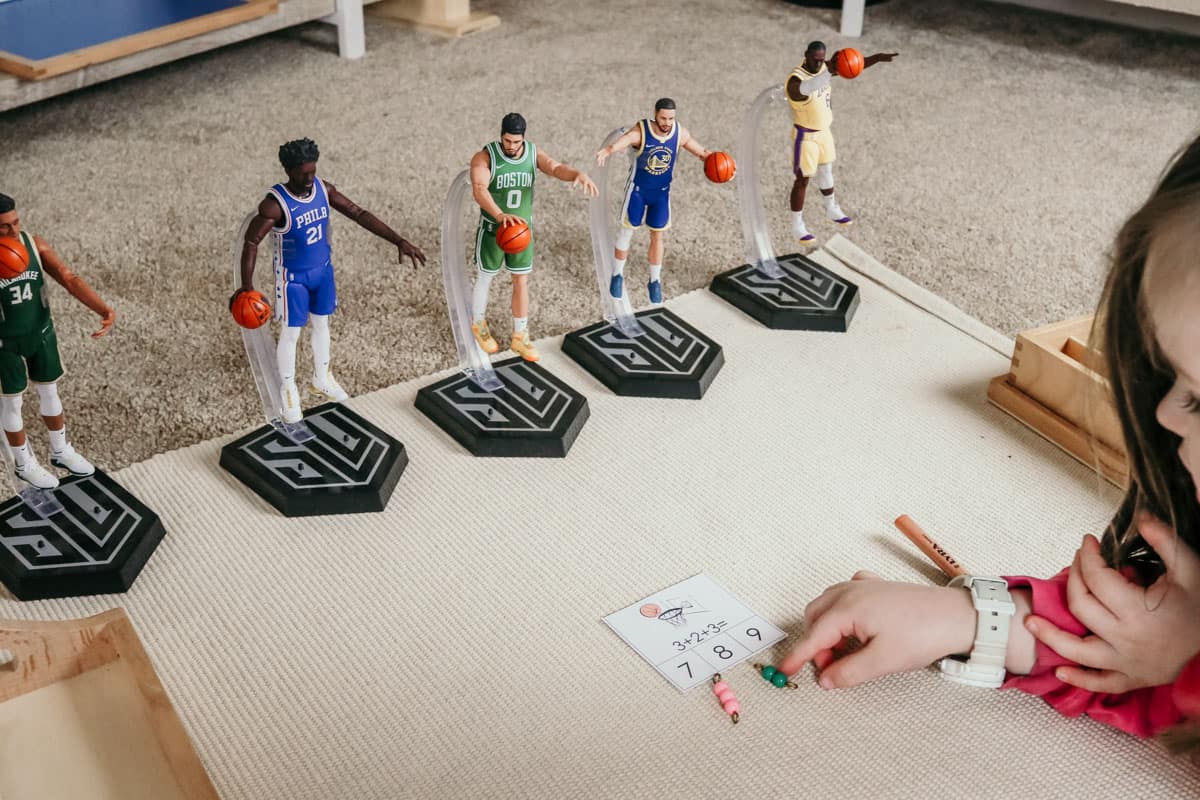
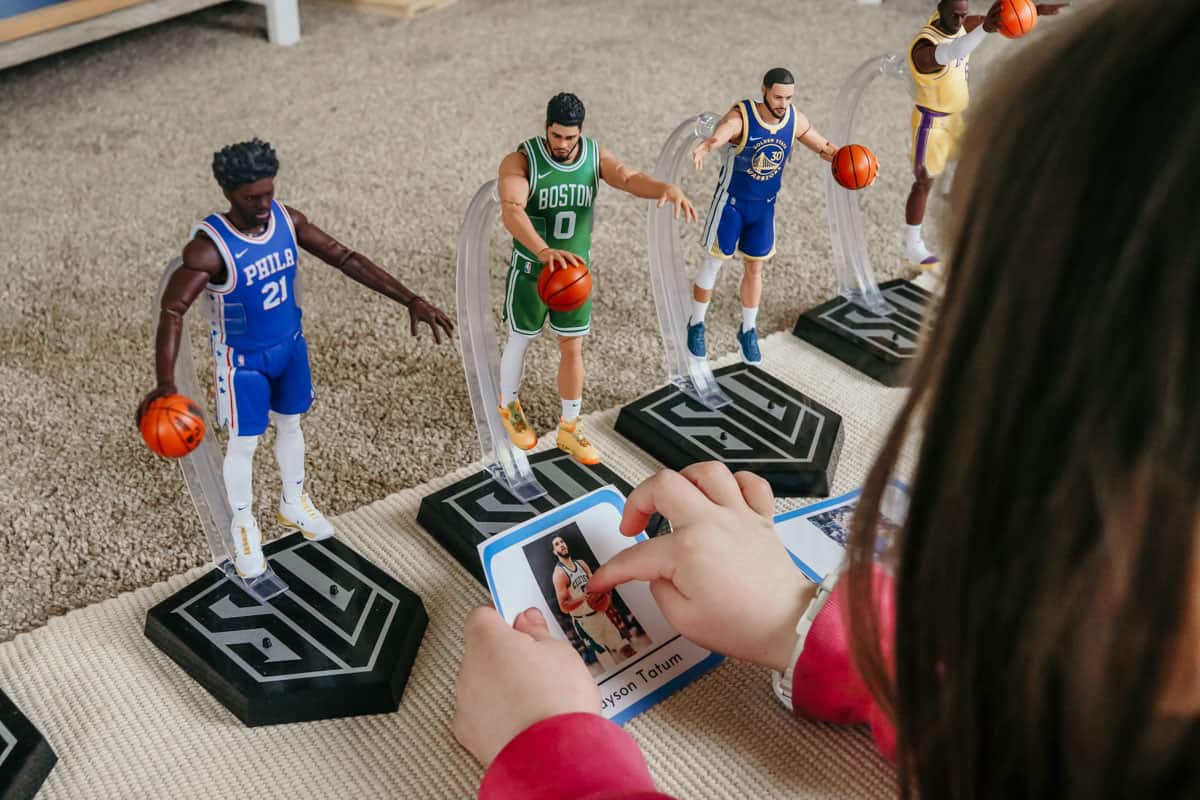
The opportunities to include sports in other subject areas are endless.
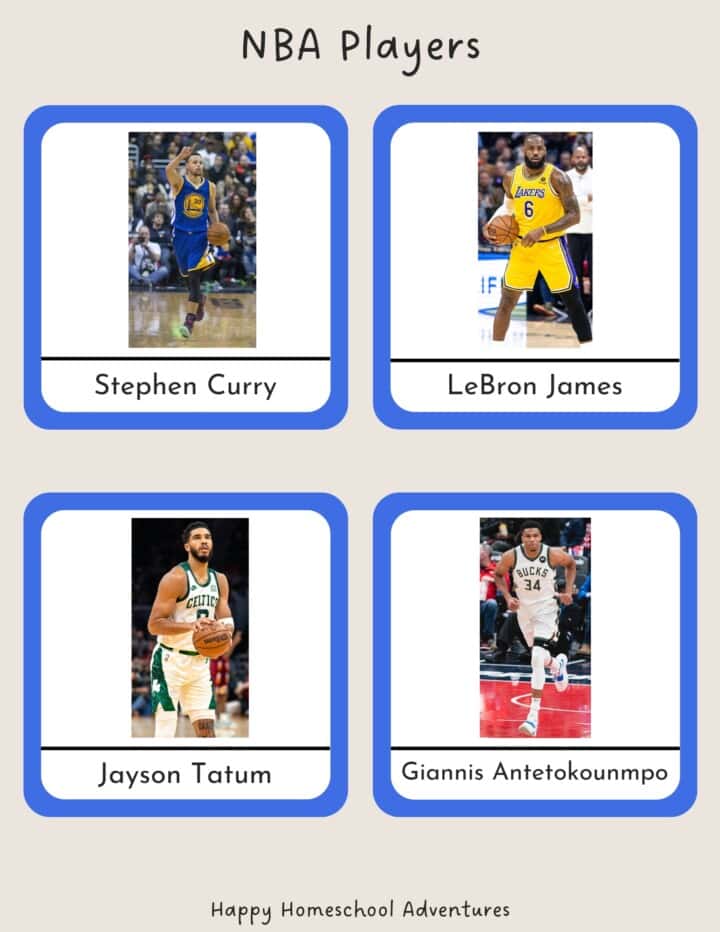
FREE NBA Three-Part Cards
Who's your favorite player?
Free NBA Basketball Players Three-Part Cards
Here are tools for exploring skin tones and learning to read. Grab your FREE three-part cards to go with your favorite players. These 3-part cards are designed to be used with a collection of NBA action figures or with your favorite books.
Match the action figures to the picture cards for object-to-picture matching.
To use these NBA player cards as 3-part cards, print 2 copies and cut the labels off one of the copies. The youngest of kids can match the picture cards. As kids are mastering letter recognition and letter sounds, they can practice matching the label as well.
Any letter sounds that vary from your typical language lessons present great learning opportunities for kids.
Learning to read has never been more fun than with materials your kids are interested in.
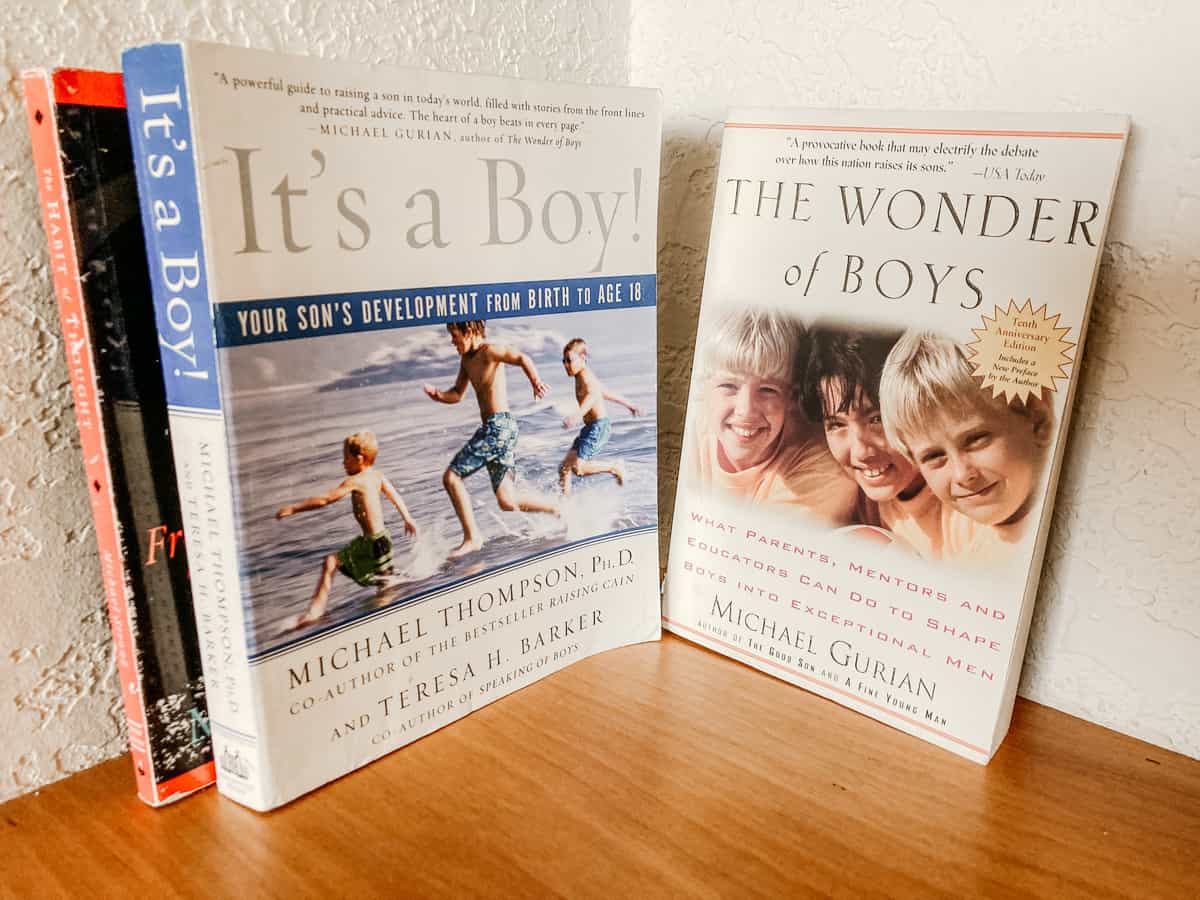
Other Cognitive, Behavioral, and Development Resources
- The Habit of Thought by Michael Strong
- It's a Boy! by Michael Thompson and Teresa H. Barker
- The Wonder of Boys by Michael Gurian
I've mentioned these books in our Elementary Curriculum also. I wanted to include them here as well since they cover a broad age range. We implement Socratic teaching principles in our homeschool with the help of The Habit of Thought. Additionally, we have two sons and are using the two books above as a resource for them.
Summary of Preschool and Kindergarten Homeschool Curriculum Resources
We use this precious collection of books to support our work as educators. They're affordable and invaluable resources that we have gained immeasurable wisdom from. At this point in our homeschooling career, they're also loyal old friends. I'm so happy to have had this opportunity to share them with you. We hope you find this useful as you plan for an exciting new year.
If you like to see more about homeschooling preschool through elementary together, visit our family-style learning.
You can find the complete list in our Montessori Primary Curriculum Resources collection on Bookshop.
More Preschool and Kindergarten Homeschool Curriculum Resources
- Montessori Minimalist Homeschool Planning: A How-To Guide
- Affordable Montessori Bookshelf Ideas for Homeschool
- The Best Montessori Sensorial Materials for Homeschool
- Self-Reflection, Mindfulness, and Books for Parents & Educators
Preschool & Kindergarten Homeschool Courses
Best Preschool and Kindergarten Homeschool Curriculum Resources

Preschool and kindergarten homeschool curriculum resources, including preschool math, preschool and kindergarten reading, discipline, kindergarten science, and more. Perfect for ages 2 - 6.
Materials
- Montessori: The Science Behind the Genius
- The Montessori Toddler
- The Absorbent Mind
- The Secret of Childhood
- Best Sensorial Materials for Homeschool
- Simplicity Parenting
- Toddler Discipline for Every Age and Stage
- Practical Life in the Kitchen - See In the Kitchen
- Sewing in the Montessori Classroom
- Wings, Worms, and Wonder
- Montessori Pets and Caring for Animals as Practical Life
- Don't Look Away
- What If All the Kids Are White?
- Different Differenter
- Raising Antiracist Children: A Practical Parenting Guide
- Native-Land.ca
- The Indigenous Digital Archive Treaties Explorer
- Indigenous Education Books
- How to Raise a Wild Child
- Coyote's Guide to Connecting With Nature
- There's No Such Thing as Bad Weather
- Play the Forest School Way
- Powerful Literacy in the Montessori Classroom
- Uncovering the Logic of English
- Waseca Biomes Curriculum
- Monarch Readers
- Natural Curiosity 2nd Edition
- Math Works: Montessori Math and the Developing Brain by Michael Duffy
- Teach Your 3-7 Year Old Math by John Bowman
- Montessori-aligned Materials and Guides by Mirus Toys
- Printables
- Bilingual Spanish-English Books
- I Wonder What's Out There
- The Habit of Thought
- It's a Boy!
- The Wonder of Boys
Tools
- See Materials List
Instructions
- Read Montessori: The Science Behind the Genius
- Slowly collect curriculum resources, keeping the preschool and kindergarten learner in mind.
- Consider ways you can connect with other parents and families.
- Add to your collection as needed throughout the year and the duration of your homeschooling journey together.
Notes
Full Resource Info and Pictures at: https://happyhomeschooladventures.com/montessori-primary-curriculum/





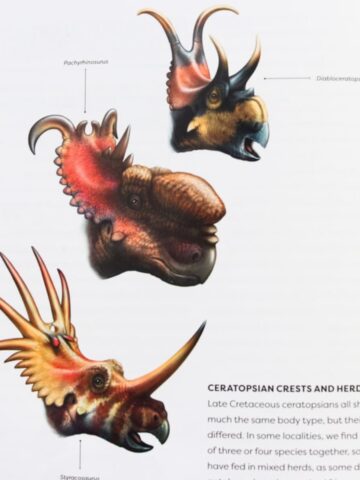
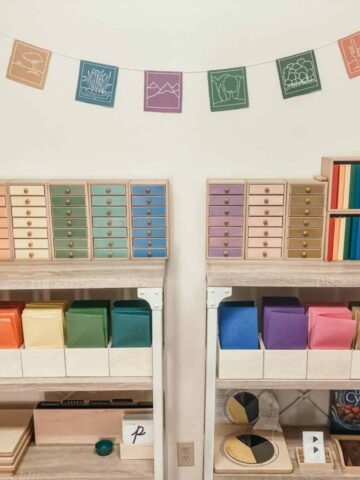
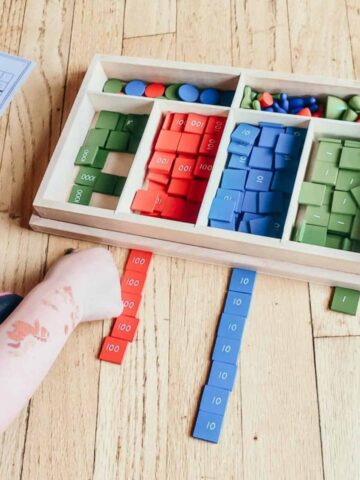
Leave a Reply